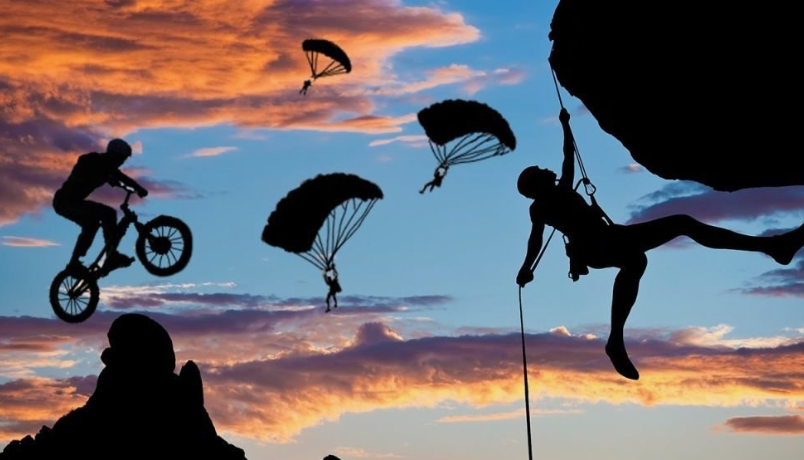Extreme sports have long captured the imagination of athletes and fans alike. From base jumping to mountain climbing, snowboarding, and skydiving, these sports push the boundaries of what the human body can endure. Extreme athletes perform feats that seem almost impossible, often reaching new heights, speeds, and physical limits that defy conventional expectations. But how are they able to achieve such extraordinary performances?
The science behind human performance in extreme sports is a fascinating blend of biology, physiology, and psychology. Athletes rely on both their physical conditioning and mental toughness to perform at their peak in high-risk, high-intensity environments. This article delves into the scientific principles that allow these athletes to break records and achieve remarkable feats of endurance and strength in the world of extreme sports.
1. The Role of Physiology: Pushing the Limits of the Body
At the core of extreme sports performance is the ability to push the body to its limits. While many sports require a combination of strength, speed, and endurance, extreme sports often demand peak physical condition to survive, let alone thrive. Let’s break down some of the key physiological factors involved.
a. Cardiovascular Endurance: Fueling Performance
In extreme sports, the heart and lungs play a vital role in supplying oxygen and nutrients to muscles during intense physical exertion. Cardiovascular endurance is crucial for athletes participating in high-intensity, long-duration events like endurance racing, mountain climbing, or long-distance running. The ability to maintain a high level of performance without fatiguing requires a highly efficient cardiovascular system.
Athletes in extreme sports often train their VO2 max, which is the maximum amount of oxygen the body can use during exercise. The higher the VO2 max, the more efficiently the body can produce energy during intense physical activity. Elite athletes often undergo specialized training, such as high-altitude training, which increases the body’s ability to transport oxygen efficiently, giving them an edge in extreme conditions.
b. Muscle Power and Strength: Explosive Movements
In many extreme sports, athletes must generate explosive force to perform high-impact movements. Muscle power—the combination of strength and speed—is critical for activities such as bungee jumping, extreme skiing, and paragliding, where a quick burst of energy is needed to perform intricate maneuvers.
Strength training, agility drills, and plyometrics (exercises that focus on fast, explosive movements) help athletes improve their ability to perform explosive actions in sports. These exercises not only build muscle mass but also improve muscle fiber recruitment, enhancing the body’s ability to generate force rapidly.
c. Flexibility and Balance: Precision and Control
Extreme athletes often perform movements that require a high degree of flexibility and balance. Whether they are performing stunts on a skateboard or navigating rocky terrain during an ultra-marathon, athletes must have the range of motion and body control to execute precise, calculated movements under pressure.
Flexibility training, such as yoga and dynamic stretching, is essential for extreme athletes to maintain mobility in their joints and muscles. Balance exercises also play a crucial role, especially for those in activities like snowboarding, skateboarding, and rock climbing, where maintaining stability is critical for safety and performance.
2. The Mental Game: Psychological Resilience in Extreme Sports
While physical training is undeniably important, mental toughness is just as critical when it comes to succeeding in extreme sports. Athletes often perform under high-stress conditions, where the risk of injury or failure is high, and the consequences of mistakes can be severe. The ability to control fear, stay focused, and push through pain is often what separates elite performers from those who don’t make the cut.
a. Focus and Concentration: Staying Present Under Pressure
In extreme sports, athletes often operate in environments that require high levels of focus and concentration. For example, a free-solo rock climber must block out distractions and focus entirely on every grip and foot placement to avoid falling. Likewise, a freestyle skier needs to stay in the moment when navigating difficult terrain or executing aerial stunts.
To stay focused under pressure, extreme athletes use a variety of mental techniques. Mindfulness and meditation are increasingly being adopted by athletes to help improve concentration and deal with the stress of competition or training. These mental exercises allow athletes to regulate their emotions, focus on the task at hand, and block out distractions.
b. Fear Management: Overcoming the Fear of Injury and Death
The high-risk nature of extreme sports means that athletes often have to overcome their fear—whether it’s the fear of falling from great heights, the fear of injury, or the fear of failing in front of an audience. Managing fear is a critical skill that separates professional athletes from amateurs in extreme sports.
Psychological strategies such as visualization and self-talk are commonly used to help athletes manage fear and anxiety. Visualization techniques involve mentally rehearsing actions and overcoming challenges, allowing athletes to mentally prepare for high-risk situations before they occur. Self-talk, on the other hand, involves positive affirmations and encouragement that athletes can use to stay calm and focused.
c. Motivation and Grit: Pushing Through Pain and Fatigue
In extreme sports, athletes are often faced with physical exhaustion and pain, and the ability to push through these barriers is what makes them exceptional. This is where the concept of grit comes into play—a combination of perseverance, passion, and resilience.
Many extreme athletes train their mental toughness by embracing discomfort during training. They push through the pain of sore muscles, extreme temperatures, and psychological challenges to build the mental resilience needed for competition. The combination of physical strength and mental fortitude allows athletes to continue performing at a high level, even when their bodies are telling them to stop.
3. The Role of Technology in Enhancing Performance
Advancements in technology have also played a major role in improving performance in extreme sports. Wearable technology, biomechanics, and performance tracking devices are now used by athletes to monitor their health, improve their technique, and maximize their output.
a. Wearable Technology and Data Analytics
Wearable devices like fitness trackers, heart rate monitors, and GPS watches have become essential tools for athletes training for extreme sports. These devices track metrics such as heart rate, distance traveled, altitude, and even body temperature, providing athletes with real-time data that can help them optimize their performance.
For example, mountain climbers can track their ascent and monitor their physical condition during long expeditions. Snowboarders can use GPS tracking to analyze their runs, speed, and jumps. The data allows athletes to adjust their strategies, improve their technique, and ensure they’re in peak condition for competition.
b. Biomechanics and Performance Optimization
Technology also allows extreme athletes to study their biomechanics—the movement of their bodies in space—through high-speed cameras and motion-capture systems. Analyzing these movements in detail can help athletes improve their form, reduce the risk of injury, and enhance their performance.
For example, paragliders can use wind tunnel simulations to optimize their flight techniques, while base jumpers can assess their body position during free fall. By understanding the science of movement and how their body interacts with external forces, athletes can push their limits safely and effectively.
4. Nutrition and Recovery: Fueling the Body for Extreme Demands
Nutrition and recovery strategies are crucial for athletes who push their bodies to the limit in extreme sports. Proper fueling through balanced diets and recovery techniques ensures that the body can recover from strenuous activities and perform at its best.
a. Nutritional Strategies for Extreme Athletes
Extreme athletes require a unique balance of macronutrients—carbohydrates for sustained energy, proteins for muscle repair, and fats for long-term fuel. Many athletes also rely on supplements like electrolyte drinks, amino acids, and creatine to support recovery and maintain energy levels during intense physical activity.
b. Recovery Techniques: Reducing Fatigue and Injury Risk
Recovery is equally important in extreme sports. Techniques such as cryotherapy, massage therapy, and foam rolling are commonly used to reduce muscle soreness, improve circulation, and speed up recovery time. Rest days and sleep are essential for ensuring that muscles can rebuild and prepare for the next challenge.
Conclusion: Breaking Barriers in Extreme Sports
Breaking records in extreme sports is no simple feat. It takes a combination of cutting-edge technology, mental resilience, and unparalleled physical conditioning. Athletes are constantly pushing the boundaries of human performance, and the science behind their achievements continues to evolve.
As advancements in sports science, psychology, and technology continue, the possibilities for breaking records and achieving new heights in extreme sports are limitless. Whether it’s climbing the world’s tallest peaks, breaking speed records on the slopes, or defying gravity with daring aerial stunts, extreme sports athletes will continue to challenge the limits of what the human body can achieve.


